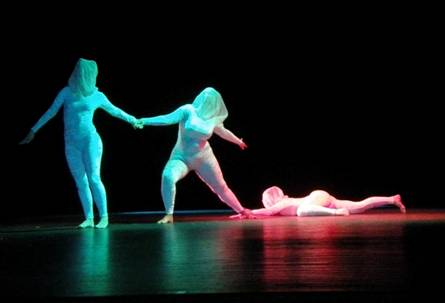|
 |
|||||||||||
|
|
||||||||||||
|
Review of Saturday Night X-MED Performance Show by Z-Helene Review of Sunday Night X-MED Performance Show by Sonya Taft and M’lilah
Added from the Program: In Egyptian mythology, the stork was often associated with the “ba” or personality, the unique individual character of each human being. The Egyptians linked the migratory behavior of the stork to the soul's departure from and return to a sleeping human; they also thought that the “ba” could return to the body of a deceased person, because that was its rightful home. This is a new work in progress.
Z-Helene’s Review: The last dance of the show was my favorite. Called “Scylla,” this piece was choreographed by Djahari and Elayssa and also had an original score to accompany it. (Music: Original composition by Brian Havey, Tim Lamb, Mark Messing – Produced by Djahari Clark - Costumes: Kristin Costa) Performers: Desert Sin: (Djahari, Amara, and Lorraine)
If you weren’t at one of the two shows presented Labor Day weekend as part of X-MED, you missed out on a daring event! I was a bit apprehensive about trying to review this show, since it is so far outside our normal parameters, but hopefully the pictures by Val Aguirre will help convey what a cool event this was. One of the best parts was that each performer came out after the number and allowed a question and answer time regarding the performance.
This piece starts with a coffin in the middle of the stage, and a man comes to lay a white rose by the headstone. A mysterious priestess appears, and offers solace to the grieving man, but her true intent is to get close enough to slip a knife between his ribs. She pours the blood into the coffin onto the body, which resurrects her vampiric goddess, who revels in her newly animated flesh, but cannot escape her prison. She ends up descending back into her coffin, hungering for more but unable to sustain herself. This was a striking opening piece; the bright red of the blood on her pale skin in that dark theatre was a real stunner. Her movements were sinuous and showed great strength and balance, especially in a slick, plastic-lined, small space like her coffin. Her Q&A revealed that blood as a prop is difficult, and can be unpredictable, so the dance is blocked, but not specifically choreographed. The mixture is uncomfortable, if it gets in the eyes, and leaves a reddish stain for days after the performance (it has a base of corn syrup). Talk about suffering for your art, this shows a whole new level of dedication! Added by M’lilah: The music was “All She Could Ask For” by Creatures from Hybrids and excerpts from Dead Can Dance. The blood was very realistic, and the performance so jarring to my sensitivities that I was actually not able to enjoy the remainder of the show without images of that red blood returning to my mind over and over. The program description reads, “The sacrifice of blood can bring a waiting spirit breath again, but it may never fully walk this earth again.” and my thoughts were “thank goodness.” During the Q&A the actress said she felt “evil, sexy, frustrated and not at all satisfied by the meager amount of blood which left her alive but still trapped by death.” An excellent performance.
This piece starts from the back of the theatre, and allows the performer to interact with the audience on her way to the stage. Baba Yaga is a character from Russian folklore, sometimes conveyed as an ancient, evil witch, but also as one who can grant you wisdom. The real “twist’ in this dance is that the face of the mask is on the back of the dancer’s head, and her face is covered by the witch’s scarf. This alters the direction all the limbs seem to move, creating a truly alien affect. She uses a piece of music commissioned specifically for this dance, created to be the sounds she makes while walking. I know at least twice during the dance I genuinely forgot which way was up on this dancer. The angles the body makes when backwards, as well as this dancer’s excellent range of motion, can make any number of normal things look really creepy, which was added to by the jiggly jaw on the mask, and the beady eyes that frequently seemed to find eye contact with us. She has taken “eyes on the back of your head” quite literally! Her Q&A informed us that she had been researching witches, and found Baba Yaga to be most interesting. She had considered trying to make a whole dance in reverse, but decided that Baba Yaga herself should be backwards, instead. The creative process included teaching another dancer the part, so she could watch it and make corrections to add believability and interest to the character, then dancing it herself. This was the first time Baba Yaga appeared as a solo. She had been included in other earlier X-MED productions. Added by M’lilah: “Baba Yaga” was a story of an extremely evil witch who appears in many Russian folk stories. Djahari’s costume was designed with an extremely ugly witch mask on the back of the actresses head and during the Q&A, she spoke of how difficult it was to concentrate on where the face was really “looking.” With her own face obscured by Baba Yaga’s veil, she started out on the side aisle and by moving backward through the audience before moving up onto the stage. It was so well done, the artist’s robotic movements giving realistic life to Baba Yaga, that I was only aware of the witch as the character. The program adds, “BabaYaga is the crone, the witch, and the earth-mother of Russian folklore. Not to be trusted, she may aid those who are pure of heart but eats the souls of those that visit her unprepared or those who cross her. Ominous and a bringer of death, you generally do not want to meet her in the woods. Wild and untamable, Baba Yaga is a nature spirit bringing wisdom and death, and through death, re-birth.” The music choice was interesting; an original composition written by Casey Arrillga especially for this performance. During the Question and Answer session, Djahari said she did not want the piece to be monotonous or too scary. She succeeded. Wrong Side of Nowhere” by Amara This was an excellent tour in all the shapes that can happen over time, when you are exploring slow movement. The first minute features her feet, which she uses to create a window into the character’s mental state. The hidden veil is a great surprise; there was no sign of it when she started. It was like magic. She picked movements that really exemplified the emotions she was intending to convey, and her floor path also worked towards that end. Her Q&A helped explain her creative process, how she keeps in top shape to be able to do all this, and the fine line she walks between choreography and improvisation. I had to ask of course, where does one buy a straight-jacket, and she told us it was custom made for this dance, to look real but be able to be shed at the right time.
“Falname” by Sahira & Silvia From the program: “Drawing on the resources of traditional Oriental dance (belly dance) and the unique expressivities that it brings to the human body; creating curves that embody the feminine spirit; Falname takes us through an evolutionary journey in the images and shapes that two bodies take on stage while bridging traditional and modern movement vocabularies.” This dance was the closest of the evening in movement, music, and costuming to what we likely think of when you say Middle Eastern dance. Much of the dance was recognizable moves from our vocabulary, but with the added dimension of creating similar motion while facing different directions, not always an easy task. In addition to fusing in some Modern dance elements, they also used contact dance, lifting and turning a body in the air, a technique rarely used in our genre. I was amazed at how synchronized they were, always like two puzzle pieces that fit together perfectly. Their Q&A took us through the process of finding the perfect song, and the concept of choreographing the space between the bodies, not the bodies themselves. Sahira says she’s actually terrified of the lift aspects, but that Silvia seems obsessed with throwing her about, and they will take this idea further at a debut performance of a new piece at Third Coast Tribal in January, 2012. Added by M’lilah: Silvia and Sahira so closely resemble each other, both in body and talent that their performance seemed at times a mirror reflection and at times the connection they made with each other literally sent a chill up and down my spine. I thoroughly enjoyed their performance and it alone was worth the price of the show ticket. My only disappointment was that it was too short! Their music, ‘Falname’ by Mercan Dede is from the album “Sufi Traveler.”
“Ditma” by Ya Helewa! (Amara, Djahari, and Randi) This dance used the whole stage, which was huge. There was no narrative, but it was three bodies specifically representing different parts of the song, and the slightly obscured faces made it easier to think of each dancer as a piece of music, not a woman. This piece also included the breaking of “normal” personal space boundaries, by having two dancers try to anchor one down by her hips and heel, as well as a dancer slapping out the rhythm on another dancer’s legs. Having the dancers all in white made it possible for them to seem to be in different colored costumes as they moved through the stage lighting.
Their Q&A gave us some insight on how Amara hears and breaks down music to create choreography. We also heard that the two dancers learned this whole dance separately, via DVD’s, and only rehearsed it together when they arrived in Austin for the seminars a few days ago. Clearly art has no boundaries, as this one started in different states and became one with itself here in Austin, Texas. Added by M’lilah: Again, straight from the program, the final performance of the evening with Ya Helewa! (Amara, Djahari, and Randi) was meant to be “a study of abstract, awkward and uncomfortable” and that description certainly fit. It was together (their faces were veiled, and their white crushed velvet “cat suit” leotards were designed to show their bodies as they moved), it was abstract, it was awkward (they were never really together but never really apart as each moved independently around the stage) and the fact that I never did figure out what it was supposed to tell me, it was uncomfortable. Interesting.
Sonya’s Final Summary In summary, I have never seen anything quite like this in our scene. The lighting was top notch, truly adding to the feel of each dance. Stage Lighting arranged by Joseph Hartfield. The costuming was no accident, many parts being made by hand specifically to serve a purpose in this show. The music ranged from Indie to Industrial, including custom mixes and original compositions. The audience, though small, were very responsive and had some interesting questions to ask of the performers. Congratulations are in order to Amara, for hosting such a unique event, and to all the performers, for opening our eyes to new possibilities. Although I viewed these more as theatrical pieces that included some Middle Eastern dance, I can totally see how adding some theatre to our dance form would really expand our horizons. I imagine we’ll see more of this intriguing combination in the near future of our dance, and I look forward to reviews of the workshops, to see how it can be done. From the Press Release: by Amara
All Pictures are by Valerie Aguirre
|

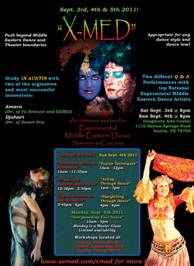
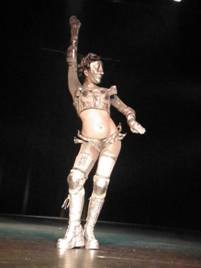 ACT 1
ACT 1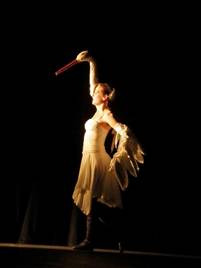 Z-Helene’s Review: The second piece (Music: Jean-Yves Thibaudet - Album Leaf Costume: Djahari, Kristin Costa), by NYC-based dancer and show co-producer Djahari Clark, was called “The Soul's Migration.” This was a unique dance in which she portrayed a stork. The emotional aspect of this piece was mysterious, in that there was a sleeping -- perhaps deceased -- stork lying on the edge of the stage that she would periodically return to and fly away from. With one of her arms as the wing and the other the head, Djahari adeptly worked these extraordinary costume devices into a believable bird. The somber note of the dance brought up issues of death and soul departure.
Z-Helene’s Review: The second piece (Music: Jean-Yves Thibaudet - Album Leaf Costume: Djahari, Kristin Costa), by NYC-based dancer and show co-producer Djahari Clark, was called “The Soul's Migration.” This was a unique dance in which she portrayed a stork. The emotional aspect of this piece was mysterious, in that there was a sleeping -- perhaps deceased -- stork lying on the edge of the stage that she would periodically return to and fly away from. With one of her arms as the wing and the other the head, Djahari adeptly worked these extraordinary costume devices into a believable bird. The somber note of the dance brought up issues of death and soul departure.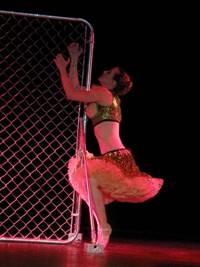
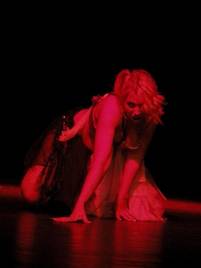 Z-Helene’s Review: The next piece was by a dancer named Tatianna. (Music: Excerpts from Sheila Chandra, Snake River Conspiracy, Evanescence, and Alicia Keyes Music Producer: Joseph of Windows to Sky). This dance was about how fear confines the soul. Once again, the costume was unusual and telling: one half was beautiful, light, and happy; the other was more sinister, dark, and vampy. Tatianna danced these two aspects of herself with a great deal of passion and ability
Z-Helene’s Review: The next piece was by a dancer named Tatianna. (Music: Excerpts from Sheila Chandra, Snake River Conspiracy, Evanescence, and Alicia Keyes Music Producer: Joseph of Windows to Sky). This dance was about how fear confines the soul. Once again, the costume was unusual and telling: one half was beautiful, light, and happy; the other was more sinister, dark, and vampy. Tatianna danced these two aspects of herself with a great deal of passion and ability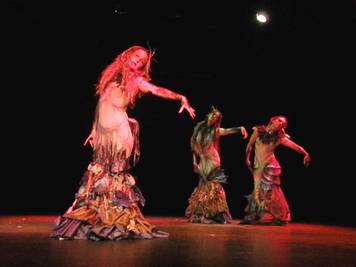 Based on the mythological character of a sea monster, Djahari, Amara and Lorraine were in fabulous costumes that were fitted on top with elaborate, involved skirts that embodied images from the sea. Truly, I've never seen anything quite like this; each dancer looked different and equally fantastic. The dancing was precise, alluring and eerie, with shocking moments of electrocutions in which they bare their evil, black teeth!!! Well constructed and expertly performed, the sea goddess Scylla is now permanently etched into my psyche.
Based on the mythological character of a sea monster, Djahari, Amara and Lorraine were in fabulous costumes that were fitted on top with elaborate, involved skirts that embodied images from the sea. Truly, I've never seen anything quite like this; each dancer looked different and equally fantastic. The dancing was precise, alluring and eerie, with shocking moments of electrocutions in which they bare their evil, black teeth!!! Well constructed and expertly performed, the sea goddess Scylla is now permanently etched into my psyche.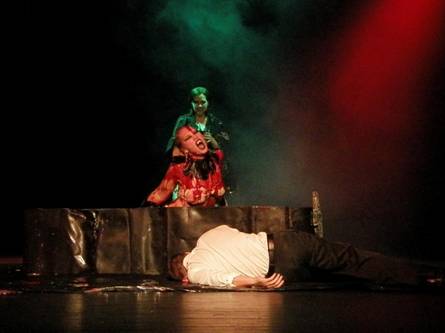 “Scarlet Affair” by Tatianna (with Justin Scalise and Djahari)
“Scarlet Affair” by Tatianna (with Justin Scalise and Djahari) 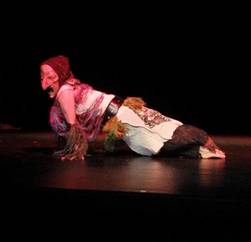 “Baba Yaga” by Djahari
“Baba Yaga” by Djahari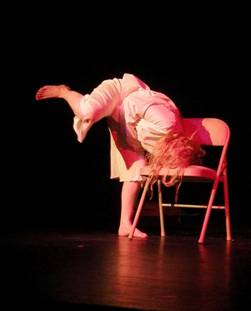
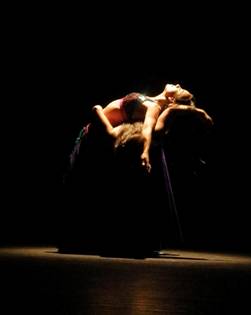 Added by M’lilah: The dance was to a medley of music from “Every Day is Exactly the Same” and “Beside You in Time” by Nine-Inch Nails, “Beneath Me” by Sia, “In the Shadow of Life” by Niyazm and “Loving You (Maroc Version)” by Nouri featuring Ydama. The dramatic piece opens with Amara in a strait-jacket; displaying extreme anguish and pain; she gradually sheds layers of clothing as well as personality to move from a mental case to a beaming, beautiful, young woman. She connected well with the audience from the very beginning, so we were immediately drawn into her character, and could easily follow her transition from one of being stuck to one of extreme relief. Again, an excellent performance by a gifted artist.
Added by M’lilah: The dance was to a medley of music from “Every Day is Exactly the Same” and “Beside You in Time” by Nine-Inch Nails, “Beneath Me” by Sia, “In the Shadow of Life” by Niyazm and “Loving You (Maroc Version)” by Nouri featuring Ydama. The dramatic piece opens with Amara in a strait-jacket; displaying extreme anguish and pain; she gradually sheds layers of clothing as well as personality to move from a mental case to a beaming, beautiful, young woman. She connected well with the audience from the very beginning, so we were immediately drawn into her character, and could easily follow her transition from one of being stuck to one of extreme relief. Again, an excellent performance by a gifted artist. 